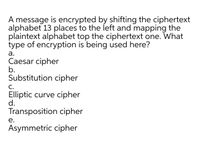In the realm of cryptography, an intriguing conundrum lurks beneath the surface: does the same message always produce the same ciphertext? This question, while seemingly straightforward, sets the stage for a deeper exploration of the intricate principles that underpin encryption systems. The answer can vary significantly depending on the specific encryption method employed, establishing a foundation for understanding the complexities and nuances associated with ciphertext generation.
To dissect this query, one must first appreciate the essence of a cipher. A cipher is an algorithm for encrypting or decrypting messages, transforming plaintext into ciphertext—and vice versa. The simplest form of ciphers, such as the Caesar cipher, operates on a uniform principle: it shifts each letter of the plaintext by a fixed number in the alphabet. For example, if one chooses a shift of three, ‘A’ becomes ‘D’, ‘B’ becomes ‘E’, and so on. If you encrypt the same plaintext, “HELLO”, using the Caesar cipher with a shift of three, you will invariably produce the same ciphertext. In this case, “HELLO” consistently transforms into “KHOOR”. This highlights a crucial aspect of most basic, symmetric encryption schemes: determinism—or the consistent mapping of input to output.
However, the discussion becomes multifaceted when one introduces more sophisticated encryption mechanisms. For instance, consider a block cipher like the Advanced Encryption Standard (AES). Block ciphers encrypt data in fixed-size blocks and utilize complex algorithms to ensure security. A key characteristic of many block ciphers, including AES, is the reliance on a secret key in conjunction with the plaintext. Herein lies an essential distinction: although the same plaintext can, in theory, yield identical ciphertexts when the same key is applied consistently, the overall security and unpredictability of the system are bolstered through other mechanisms, such as initialization vectors (IVs).
Initialization vectors are random values incorporated into the encryption process to ensure that even when the same plaintext is encrypted with the same key, the resultant ciphertext can differ dramatically. For example, if “HELLO” is encrypted once with a specific IV, it might yield “KHOOR1”, and when encrypted again with a different IV, the same plaintext could result in “KHOOR2”. This randomness introduces a layer of complexity and security vital in modern cryptographic systems, effectively rendering the same message non-deterministic when processing under differing conditions.
Beyond technical variations, the inherent nature of the encryption method—combined with its application—further dictates whether an identical message will consistently yield the same ciphertext. For example, stream ciphers, which encrypt plaintext one bit or byte at a time, often employ a keystream that is created algorithmically. If the keystream varies (due to random initialization or other mechanisms), the same plaintext can once again produce divergent outputs. Thus, the intricate dance of randomness, keys, and algorithms creates a rich tapestry in which the outcome varies dramatically, fostering an environment resistant to cryptanalysis by adversaries.
Another critical aspect of encryption is randomness, often masquerading as an adversary to predictability. Analyzing the impact of randomization highlights the essential characteristics of secure encryption. The addition of entropy—often derived from unpredictable physical phenomena—ensures that even the smallest changes in input, whether through IVs or random keys, lead to significant alterations in the resultant ciphertext. This property is foundational to maintaining confidentiality, ensuring that even if an adversary gains access to ciphertext, without the proper keys and parameters, decrypting the message becomes an impractical endeavor.
To address the playful question posed earlier, the answer is nuanced: while certain elementary ciphers yield consistent ciphertext when the same plaintext and conditions are applied, more advanced methods equipped with randomization techniques present a different reality. The potential challenge emanating from this non-determinism—the intricate intertwining of keys, randomness, and cipher types—urges both cryptographers and cybersecurity professionals to continuously innovate and adapt.
Encryption is not merely a one-dimensional path but a labyrinth of choices, mechanisms, and outcomes. As cryptography evolves in response to emerging threats, the dialogue surrounding deterministic versus non-deterministic encryption continues to unfold, illustrating the significant implications for securing sensitive information. The bedrock of trust in digital communication hinges on understanding these principles, fostering a resilient cyber environment.
In summary, whether the same message generates the same ciphertext relies heavily on the encryption methods utilized. In simplistic methods, yes; in sophisticated frameworks, not necessarily. This rich interplay of consistent algorithms, coupled with unpredictable randomization, cements the significance of diversity in cryptographic applications, ultimately underpinning the security measures instructional within our interconnected world.








Leave a Comment